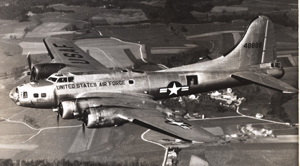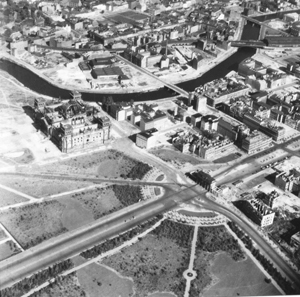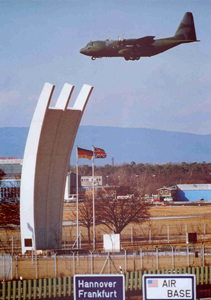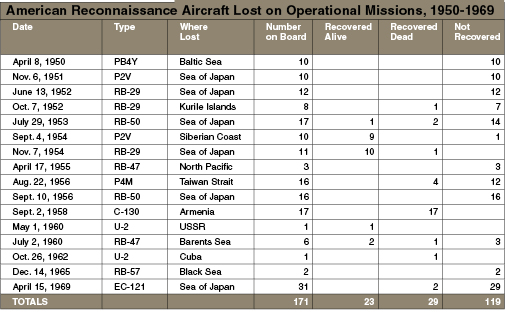Three air routes to West Berlin were established after the end of World War II to give the Western Allies air access to their garrisons in the former Nazi capital.

| ||
|
A RB-17G flies a mission over West Germany in the mid-1950s. (Photos by Bob Brewer via the 7499th Group Association) |
When the Soviet Union imposed its blockade in 1948, these air routes became famous as the vital corridors of the Berlin Airlift, which enabled the British and Americans to supply the beleaguered city. It is less well known that they were also, for 44 years, how the Allies collected intelligence on the densest concentration of Soviet military forces in the world.
The “Berlin for Lunch Bunch,” as the aircrews called themselves, used three routes in operations for what was arguably the most important, longest lasting, and successful military reconnaissance program of the entire Cold War.
The air routes into Berlin came about as a result of the Potsdam Conference in July 1945. President Harry Truman, British Prime Minister Winston Churchill, and their entourages needed to fly in and thus required air access to the city.
The Soviets cooperated fully with the British and Americans, setting up temporary air facilities at Gatow Airfield in the British sector. Two ad-hoc air corridors, as well as navigation and landing aids, were established. Air support to the conference went well, and the Western Allies assumed this would continue as they established their garrisons.
An Intricate History
However, shortly after the conference ended, the Soviets began to complain that the Allies were flying outside the agreed corridors and this would not be tolerated. Much detailed discussion ensued, at the beginning of which the British recorded Marshal Georgy K. Zhukov, commander of Soviet forces in Germany, as stating that a corridor was necessary “to prevent your aircraft from observing Russian armies.”
The four powers ultimately signed a written agreement in November 1945, establishing three corridors, a circular control zone, and the four-power Berlin Air Safety Center to coordinate air activity within the corridors and control zone. This was a written document, unlike the arrangements on land and water access to West Berlin. It may have been a major reason the Soviets did not try to shut the air corridors down during the Berlin blockade and helped avoid a violent East-West confrontation, ensuring the success of the Berlin Airlift.
The corridors also led to the successful covert reconnaissance that was about to begin.
The history of the reconnaissance squadrons destined to become corridor intelligence collectors is intricate. Although American recon activity may have begun earlier, the earliest hard evidence notes the establishment of a special secret Douglas A-26 Invader flight within the 45th Reconnaissance Squadron. Equipped with special cameras, the light bombers were supposedly modified for VIP transport, so they could fly to and from Berlin without suspicion.
Another separate, secret activity began with two shootdowns. On Aug. 9, 1946, a Douglas C-47, en route from Vienna, Austria, to Italy inadvertently entered Yugoslavian airspace and was shot down by Yak-3 fighters. All aboard survived but were interned, causing a furor in the State Department.
 | ||
|
Berlin’s famed Brandenburg Gate, just inside the border of East Berlin, is seen in this 1954 surveillance photo taken from a B-17 photo recon aircraft. (Photos by Bob Brewer via the 7499th Group Association) |
While talks were under way to free the internees, a second C-47 on a courier flight became lost in bad weather and was shot down by Yugoslav fighters in the same area. US Air Forces in Europe directed that two Boeing B-17s be quickly equipped as photo-mapping aircraft with electronic intelligence (Elint) collection gear. The B-17s soon discovered that the Yugoslavs had used captured German radar equipment to track and intercept the C-47s.
Intrigued by this discovery and also by intelligence that the Soviets were deploying radars in their zone of Germany, USAFE directed the formation of a secret Elint and photo B-17 unit.
In March 1947 the 45th Recon Squadron moved to Fürstenfeldbruck Air Base, near Munich, where it was later joined by the special B-17 photo-Elint detachment. Both elements began flying border, or “peripheral,” recon missions and corridor flights. More than a year later, on Nov. 1, 1948, the B-17 element became the 7499th Air Force Squadron and later still the Invader element became the 7498th. The two merged into the 7499th Composite Squadron in 1950.
By June 1948, the Soviet Union wanted to have Berlin in its sole possession and decided to oust the Western Allies from their occupation sectors. The Soviets blockaded the roads, railways, and canals into Berlin, but allowed the air corridors to remain open. These air corridors were the only viable Allied option for keeping West Berlin supplied. Given the enormous Soviet superiority in numbers, a ground battle to reopen land access was out of the question.
When the blockade went into effect, the Soviet Union had roughly 300,000 men surrounding Berlin, including massive numbers of tanks, artillery, and aircraft. In contrast, the three Allied nations—France, Great Britain, and the United States—had a total of just over 20,000 men in the city, almost all in noncombat positions.
Caught in the midst of its relentless policy of unilateral disarmament, the United States responded with a phantom threat of nuclear-armed B-29s and the establishment of the Berlin Airlift, during which the US accelerated its corridor intelligence operation. Douglas C-47s equipped with cameras under the floorboards flew the photo missions during the day, and Elint flights by B-17s occurred at night.
Pie, Creek, Flea
The 7499th Support Group moved to Wiesbaden Air Base, near USAFE headquarters, in 1950 and received photo- and Elint-equipped Douglas C-54s to replace its B-17s. The C-54s, B-26 Invaders, and C-47s continued to fly the corridor routes disguised as transports, and the Soviet Union continued to identify them and their mission without protesting. The equipment was regularly upgraded.
Camera varieties included those with different focal lengths, from six-inch vertical to the huge 240-inch oblique camera of a Boeing C-97A Stratofreighter, first used in 1953. This aircraft, code-named Pie Face, usually operated along the borders of the Soviet Union’s satellite nations, at altitudes up through 30,000 feet.
The 7499th C-54s also covered the borders. The C-54s and the C-97 flew many peripheral missions along the Iron Curtain from the Baltic Sea around to the Black Sea. But Pie Face would also occasionally fly into West Berlin’s Tempelhof Airfield, snapping high-resolution photos all the way. The photo C-54s pioneered the operational use of infrared collection systems, and their Elint counterparts incorporated elaborate electronic suites. With these “newer” aircraft came the use of sliding panels to cover camera ports and antennas and retractable radomes to hide their true mission.

| ||
|
A 7405th Operations Squadron C-130 returns to Rhein-Main AB, Germany, after flying the squadron’s last covert reconnaissance mission in 1990. (Photo via 7499th Group Association) |
While the trips into Berlin had become routine, the requirement for information had not, and the units, equipment, and mission profiles continued to evolve over time.
The group in 1959 acquired four Convair T-29s to replace RB-26s and C-47s. They had been reconfigured from their navigator training role to carry carefully concealed camera systems. They ostensibly flew daily courier flights between Wiesbaden and Tempelhof as a cover story, but of course, while carrying light cargo and unsuspecting passengers, they were photographing Soviet military targets throughout the corridors and control zone.
In the early 1960s the Pie Face C-97A departed and five Boeing C-97Gs arrived. Two were outfitted with improved photo and infrared gear and were a valuable addition on missions on the periphery as well as in the corridors. Two others, specialized Elint collectors, had too many visible antennas and ungainly protrusions to fly corridor missions, so they specialized in peripheral collection.
But the fifth C-97G, given the name Creek Flea, was dedicated to highly specialized collection against a long series of major Elint targets, the first being the radars of the Soviet SA-2 surface-to-air missile system. The Berlin corridors were uniquely important for this collection because by the mid-1960s there were four SA-2 sites directly under the corridors, allowing this special C-97 to fly over them, gathering detailed information on all the important radar electronic parameters. Photo equipment on board supplemented the Elint and enhanced its value.
This collection program became vital to US air forces coping with SA-2 sites in North Vietnam during the Vietnam War. Its information enabled aircrews to detect, evade, and deceive the missiles, and destroy their launch sites, dramatically reducing casualties.
Beginning in the late 1960s, the far more sophisticated Boeing RC-135 aircraft of Strategic Air Command gradually assumed the peripheral reconnaissance missions of the 7499th. Also, satellite photo and signals intelligence systems became more useful. By 1974 the mission concentrated almost exclusively on the corridor flights. This remained the most important area in the world to gather information on the Soviet military, and collection remained lucrative.
Electric Bird or Picture Bird
One of the group’s three squadrons, the 7405th Support Squadron, moved in December 1975 to Rhein-Main AB, West Germany, and was redesignated the 7405th Operations Squadron. (The 7499th and its two other squadrons were inactivated in 1974.) Re-equipped with three Lockheed C-130Es featuring a wide variety of sensors and cameras, the unit soldiered on, and collection grew even more valuable. A classic example of this occurred on a mission in 1982 when a C-130 named Creek Fury, in a corridor over a Soviet training area, noted a new SA-8 highly mobile, low-altitude, short-range tactical surface-to-air missile vehicle. The technical Elint operators collected information on the Land Roll guidance radar, the infrared and photo operators imaged the transporter-erector-launcher, and the scanners confirmed the vehicle was moving about the training area. This was a collection “trifecta” virtually unique at the time.

| ||
It was often claimed that the Soviets knew what these corridor missions were doing, and this proved true, as the following anecdote indicates. In 1994 a former Soviet scientific research vessel had been reconfigured as a cruise ship and was taking on passengers for an Antarctic voyage. A former 7405th T-29 navigator and his wife were chatting with the Russian ship captain who asked the navigator whether he would like to meet a retired Soviet fighter pilot who was now a member of the ship’s crew. The navigator immediately agreed.
The next evening the navigator was invited to the captain’s cabin to meet the pilot, who knew a bit of English. When the navigator said he had flown to and from West Berlin almost every day, the pilot’s face lit up and he asked, “Which you fly, the electric bird or the picture bird?”
It developed that the Soviets knew exactly what was going on, monitored the flights closely, and had tasked their fighter units to shoot down any reconnaissance aircraft that strayed from the corridors.
The “Berlin for Lunch Bunch” continued its operations through the fall of the Berlin Wall in November 1989. From that point on, the 7405th covered the Soviet exodus from Germany, a C-130 flying its last collection mission on Sept. 27, 1990. The unit was formally inactivated in January 1991, after having flown more than 10,000 missions patrolling the Berlin corridors and siphoning vital information from the very heart of the Soviet presence in Europe.
The unit’s Latin motto for years was “Veritatem Suppeditare” (“To Supply the Truth”). For 44 years it did exactly this.
| An Extraordinary Safety Record
One of the most remarkable aspects of the 44-year-long operation of the “Berlin for Lunch Bunch” corridor missions was its surprising safety record. The mission was characterized by a complete absence of crashes or aircraft being shot down. Consequently, for 44 years and spanning more than 10,000 missions, the airmen flying the Berlin missions never suffered any operational casualties. In those same years, there were other continuous reconnaissance efforts being made by the United States elsewhere around the world, and these missions saw flights felled by mechanical failures, bad weather, and outright enemy opposition that resulted in many losses. To illustrate the Berlin for Lunch Bunch’s extraordinary safety record and highlight the inherent danger and sacrifice of the Cold War USAF reconnaissance aircrews, the 7499th Group Association historian, retired Lt. Col. John F. Bessette, aided by retired Lt. Col. Vance O. Mitchell, provided the following chart on how Cold War aerial reconnaissance was a deadly serious business. |